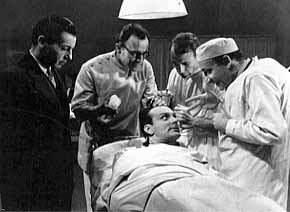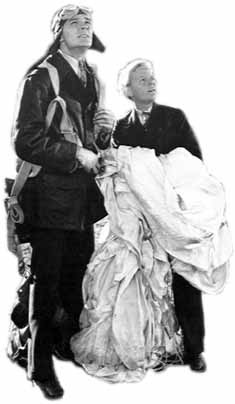|

Ralph Byrd gets squeezed
in Dick Tracy.
Much of the success of Republic's Dick Tracy can be attributed to the fine actor in the lead role--Ralph Byrd. Byrd lacked the massive frame and the rock solid nose of the comic strip character, but he possessed Tracy's anvil-shaped chin, a strong determination, and enough charisma to win over the nay-sayers in the audience. In fact, Ralph Byrd would be so identified with the role of Dick Tracy that he would continue to play the character in two B movies for RKO in the '40s and then bring the role to television in the '50s.
Some of the changes to the comic strip were unfortunate. I can't help but think the serial would be more fun to watch today if Tess Trueheart made an appearance. But even in 1937, the year Dick Tracy was made, the studios recognized that boys made up the largest part of the audience for serials and the girl-haters in the audience certainly wouldn't tolerate a girlfriend telling Tracy that he's her "bestest boyfriend," as she did in the comic strip. So the screenwriters immediately eliminated any vestige of love interest for Tracy, effectively neutering him. However, the Dick Tracy serials are still exciting stuff.

Gordon Tracy (Carleton Young), left, watches as Morloch
(John Piccori), right, prepares to operate on Dick Tracy.
After Ray Taylor and Alan James directed the first serial, the subsequent entries were turned over to William Witney and John English. As a result, the first serial looks and feels different than the ensuing ones. For starters, Dick Tracy is more serious. Almost all the comedy is relegated to Smiley Burnette. In the subsequent entries, Witney and English would create a lighter mood, more similar to the comic strip. But the first serial is dark. It even pits brother against brother as the Spider, an underworld crime boss, kidnaps Gordon Tracy and operates on his brain--leaving Gordon an evil automaton who behaves the Spider's every word. "By means of this operation--a simple altering of certain glands--he will be unable to distinguish between right and wrong," says Morloch (John Picorri), the Spider's head henchman. Gordon sports a scar on his face, a white streak in his hair (sort of like the Bride of Frankenstein), and a zombie-like stare. Directors Taylor and James even manage some pathos when Tracy discovers that he has been battling his own brother. "Brother against brother--one good, one evil. Ahh, I wonder which will win?" says Morloch.
One of the strongest reasons that the first serial is the best is the villain, the Spider. He's one of the best villains in serial history. Alternately called the Spider and the Lame One, the villain creeps through the shadows, dragging his clubfoot and making the hairs stand on his henchmen's necks whenever they hear him coming. "He isn't human!" a member of his own gang says. The serial contains several eerie sequences as the Spider slowly, methodically stalks his prey down darkened hallways and alleys. But he isn't just a shuffling bogeyman. He also controls a huge flying "Wing" that soars the skies and wreaks havoc on his enemies. (The "Wing" footage would be reused in The Fighting Devil Dogs.) With huge speakers hooked up to its underside, the Wing lets loose a powerful blast of sound waves that can destroy entire buildings. At the end of Chapter One, the Spider uses the sound waves in an attempt to destroy the Bay Bridge in San Francisco.
To keep the mood from getting too dark, however, the screenwriters did hang onto one element from the comic strip, a boy who becomes Tracy's sidekick. The boy (Lee Van Atta) helps Tracy capture the murderer in Chapter One: "It was a pretty good tackle you made there, son," says Tracy. "Aw, gee," says the boy, "that was nothing. You're Dick Tracy, aren't you? I'm just an orphan. Some day I'm gonna be a G-Man, too!" And Tracy says, "Well, now's a good time to start, come on!" And the boy instantly becomes part of Tracy's stable of sidekicks. "I'd like to keep this little rascal with me for awhile."
The screenwriters also do an admirable job of transferring the comic strip's emphasis on the importance of lab work for crime investigations. For example, Tracy and his crew discover that a crime note was written with a typewriter that uses a replaced letter "g." As a result, the FBI agents swarm over the city, looking for the typewriter. At another time, Tracy and his crew, discover the footprint of one of the Spider's henchmen contains sesame seed oil--which means the hideout must be in a vegetable oil importing house. It's fun to watch Tracy's crew working in the laboratory to unravel the clues--this isn't just mindless action. The serial emphasizes the role of brain power in capturing criminals.
The serial also contains some of the comic strip's nifty secret gadgets, such as a knife ring that Tracy uses to cut through some ropes that bind his hands in one of the later chapters.
Republic had bargained with Chester Gould to produce a "series or serial." Republic interpreted that language, much to the dismay of Gould, as justification for producing additional Dick Tracy serials. So without any additional payments to Gould, they produced Dick Tracy Returns in 1938, which was followed by Dick Tracy's G-Men (1939) and Dick Tracy vs. Crime, Inc. (1941). While some people prefer the Dick Tracy serials by Witney and English over the original one by Ray Taylor and Alan James, all of the Dick Tracy serials are among the best serials ever produced by Republic, and they're all well worth tracking down.
The Serials: An Introduction
Page 1: In the Theaters
Page 2: The Beginnings
Page 3: Enter Flash Gordon
Page 4: The Golden Age
Page 5: The Downfall
The Phantom Empire
Flash Gordon
Dick Tracy
The Fighting Devil Dogs
Zorro's Fighting Legion
The Shadow
Mysterious Dr. Satan
Spy Smasher
Perils of Nyoka
The Tiger Woman
Serials Web Links
|


 After Flash Gordon showed the studios that comic strips were fertile material for serials, Republic Pictures turned to one of the most popular comic strips--Dick Tracy. Dick Tracy had debuted in the Detroit Mirror in 1931. It soon afterwards appeared in the New York Daily News and the Chicago Tribune.
After Flash Gordon showed the studios that comic strips were fertile material for serials, Republic Pictures turned to one of the most popular comic strips--Dick Tracy. Dick Tracy had debuted in the Detroit Mirror in 1931. It soon afterwards appeared in the New York Daily News and the Chicago Tribune.


